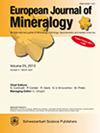Electron backscatter diffraction analysis combined with NanoSIMS U–Pb isotope data reveal intra-grain plastic deformation in zircon and its effects on U–Pb age: examples from Himalayan eclogites, Pakistan
IF 1.7
3区 地球科学
Q2 MINERALOGY
引用次数: 0
Abstract
Abstract. Zircon grains preserve records of crystallization, growth, and/or deformation that can be envisaged from their internal structures and through the U–Pb isotope analysis. Electron backscatter diffraction (EBSD) is a non-destructive method for visualizing undeformed domains to differentiate them from those that are plastically deformed. In this study, we report EBSD analyses conducted on zircon grains, in thin sections with available textural information, from Himalayan eclogites. The studied eclogite samples show no petrographic evidence of shearing or mylonitization. However, several zircon grains preserve plastically deformed domains. These deformed domains display several degrees of misorientation relative to the undeformed domain and yielded geologically reset ages when analysed for U–Pb isotope ratios using nanoscale secondary ion mass spectrometry (NanoSIMS), in contrast to most undeformed domains which retained the protolith age. The degree of resetting is positively correlated with the extent of misorientation. These pieces of evidence indicate that plastic deformation in zircon grains, equilibrated at higher pressure–temperature conditions, affected the primary geochemical and geochronological records. Based on these observations, we assume that not only regional shearing/mylonitization in metamorphic rocks affects the geochemical records, but also that zircon grains in apparently unsheared high-grade metamorphic rocks behave plastically. The micro-scale intra-grain plastically deformed domains can easily be identified through EBSD analysis in the form of crystallographic misorientations. To extract meaningful geochronological results, it is necessary to identify undisturbed domains in zircon grains before applying any destructive analytical method.电子反向散射衍射分析与 NanoSIMS U-Pb 同位素数据相结合,揭示了锆石的晶粒内塑性变形及其对 U-Pb 年龄的影响:来自巴基斯坦喜马拉雅斜长岩的实例
摘要。锆石颗粒保存了结晶、生长和/或变形的记录,这些记录可以通过其内部结构和U-Pb同位素分析来推测。电子背散射衍射(EBSD)是一种非破坏性的方法,用于可视化未变形的区域,以区分它们与塑性变形的区域。在这项研究中,我们报告了对喜马拉雅榴辉岩的锆石颗粒进行的EBSD分析,这些锆石薄片具有可用的结构信息。所研究的榴辉岩样品没有显示出剪切或糜棱岩化的岩石学证据。然而,一些锆石颗粒保留塑性变形区域。这些变形区域相对于未变形区域显示出不同程度的定向偏差,并在使用纳米级二次离子质谱(NanoSIMS)分析U-Pb同位素比率时产生了地质重置年龄,而大多数未变形区域保留了原岩年龄。重置的程度与定向错误的程度正相关。这些证据表明,锆石颗粒的塑性变形在高压-高温条件下达到平衡,影响了原始地球化学和年代学记录。根据这些观察,我们认为变质岩中的区域剪切/糜棱化作用不仅影响地球化学记录,而且在明显未剪切的高变质岩中锆石颗粒也具有塑性行为。通过EBSD分析,可以很容易地以晶体取向偏差的形式识别微尺度的晶内塑性变形域。为了获得有意义的年代学结果,有必要在应用任何破坏性分析方法之前确定锆石颗粒中的未扰动区域。
本文章由计算机程序翻译,如有差异,请以英文原文为准。
求助全文
约1分钟内获得全文
求助全文
来源期刊
CiteScore
2.80
自引率
9.50%
发文量
40
审稿时长
6-12 weeks
期刊介绍:
EJM was founded to reach a large audience on an international scale and also for achieving closer cooperation of European countries in the publication of scientific results. The founding societies have set themselves the task of publishing a journal of the highest standard open to all scientists performing mineralogical research in the widest sense of the term, all over the world. Contributions will therefore be published primarily in English.
EJM publishes original papers, review articles and letters dealing with the mineralogical sciences s.l., primarily mineralogy, petrology, geochemistry, crystallography and ore deposits, but also biomineralogy, environmental, applied and technical mineralogy. Nevertheless, papers in any related field, including cultural heritage, will be considered.

 求助内容:
求助内容: 应助结果提醒方式:
应助结果提醒方式:


